| |
|
Xiamen Oil Paintings, Wholesale Direct!
|
|
100% hand painted, 100% cotton canvas, 100% money back if not satisfaction. |
|
|
|
|
ART WORKS INDEX
A
B
C
D
E
F
G
H
I
J
K
L
M
N
O
P
Q
R
S
T
U
V
W
X
Y
Z
|
|
ARTISTS INDEX
A
B
C
D
E
F
G
H
I
J
K
L
M
N
O
P
Q
R
S
T
U
V
W
X
Y
Z
|
|
|
|
|
|
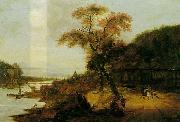 |
Jacob van der Does
|
|
(4 March 1623, Amsterdam - buried 17 November 1673, Sloten) was a Dutch Golden Age landscape painter.
Van der Does was the son of the secretary of the Amsterdam city council. He was more attracted to the arts than to note-taking, and went to study drawing with Claes Corneliszoon Moeyaert. He left at 21 to go to France, and from there on foot to Italy. In Rome he joined the Bentvueghels and was dubbed Tamboer, which means drummerboy, since he was somewhat short and had been meant for the military life. He studied with Pieter van Laer (Bamboots). When he eventually returned North, he settled in The Hague where he married Margaretha Boortens and got 4 sons and a daughter. His wife died in 1661. Houbraken liked his natural style of painting, and especially his way of painting sheep was very admirable.His wife's sister was Maria Boortens, and they both were good artists themselves. All three of them made drawings for the album of the wealthy Hague diplomat Cornelis de Glarges in 1659. Through Maria Boortens, Jacob van der Does was connected to Jacob van Campen and Adriaen van Nieulandt the younger. He became involved in the Guild of St. Luke in The Hague. He was one of the founders of the Confrerie Pictura in 1656. His pupils were Theodor Bernoille, Marcus de Bye, Gamaliel Day, Alexander Havelaer, Anthony Schinckels, and his sons Jacob II and Simon van der Does.
|
|
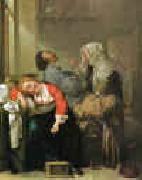 |
Jacob Duck
|
|
1600-1667
Dutch
Jacob Duck Location
Dutch painter and etcher. He was long confused with Jan le Ducq (1629/30-76). In 1621 he was listed as an apprentice portrait painter in the records of the Utrecht Guild of St Luke. His teacher was probably Joost Cornelisz. Droochsloot (1586-1666). The St Job Hospital in Utrecht acquired a Musical Company by him in 1629. By 1630-32 he was a master in the guild. Like Pieter Codde, he painted guardroom scenes (kortegaerdjes), for example Soldiers Arming Themselves (c. 1635; New York, H. Shickman Gal., see 1984 exh. cat., no. 36) or the Hoard of Booty (Paris, Louvre), in which the figures and their interactions are apparently full of underlying symbolic meaning. He also painted merry companies (e.g. c. 1630; Names, Mus. B.-A.) and domestic activities, such as Woman Ironing (Utrecht, Cent. Mus.), employing motifs perhaps symbolic of domestic virtue. He placed his figures in high, bare interiors in which the deep local colours of the foreground stand out well against the cool, greyish-brown background. Only a few of his etchings are known (Hollstein, Dut. & Flem., vi, pp. 9-11), depicting figures in contemporary dress, for example Young Gentleman with Broad Hat and Cloak (Hollstein, no. 10) or Virgin and Child with Magi (nos 1-4). Between 1631 and 1649 Duck presence is documented in Utrecht, Haarlem and Wijk bij Duurstede. Afterwards, and probably by 1656, he was living in The Hague. He was buried at the monastery of St Mary Magdalene in Utrecht.
|
|
 |
Jacob de Wit
|
|
(19 December 1695 - 12 November 1754) was a Dutch artist and interior decorator who painted many religious scenes.
De Wit was born in Amsterdam, and became famous for his door and ceiling paintings. He lived on the Keizersgracht in Amsterdam, and many of the buildings on the Keizersgracht still have door or ceiling paintings done by him. Since many of the families who lived in Amsterdam in those days had country villas, de Wit also painted in houses in the fashionable areas of Haarlem and the Vecht river.
According to the RKD he was the pupil of Albert Spiers in Amsterdam and Jacob van Hal in Antwerp where he became a member of the Guild of St. Luke in 1714. His pupils were Jan de Groot (painter from The Hague), Dionys van Nijmegen, Jan Punt, Pieter Tanje, and the brothers Frans and Jacob Xavery. De Wit died in Amsterdam in 1754.Tako Hajo Jelgersma was his follower.
|
|
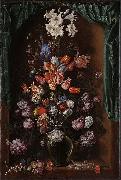 |
Jacob de Gheyn II
|
|
Jacob de Gheyn II (also Jacques de Gheyn II) (c. 1565, Antwerp - March 29, 1629, The Hague) was a Dutch painter and engraver, whose work shows the transition from Northern Mannerism to Dutch realism over the course of his career.
|
|
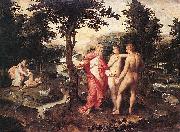 |
Jacob de Backer
|
|
(c. 1555 - c. 1585) was a Flemish Mannerist painter and draughtsman active in Antwerp between about 1571 and 1585.
According to the RKD he was born in Antwerp in c.1540/45 and died there c.1591-1600.De Backer was abandoned by his father as a young boy. Carel van Mander reports that the artist studied with Antonio van Palermo and Hendrik van Steenwijk I, but that Palermo worked him so hard that the young de Backer died in the arms of his master's daughter at the age of thirty.
Although the artist painted in the high mannerist style of Giorgio Vasari, he never appeared to travel to Italy. A series of the "Seven Deadly Sins", however, was bought in Antwerp by Alessandro Farnese's secretary Cosimo Masi in 1594 and taken to Italy.These paintings are now in the Museo di Capodimonte in Naples. Other attributable works include a Last Judgment triptych by him or his studio for Christophe Plantin's tomb in the Antwerp Cathedral (c. 1589; illustrated right), and an Allegory of the Three Ages of Man in the Hermitage Museum, St. Petersburg.
He is not to be confused with the Dutch Golden Age painter Jacob Adriaensz Backer from
|
|
|
|
|
|
|
|
 |
Ignazio Danti
|
|
Italian,1536-1586
was an Italian priest, mathematician, astronomer, and cosmographer. Danti was born in Perugia to a family rich in artists and scientists. As a boy he learned the rudiments of painting and architecture from his father Giulio, an architect and engineer who studied under Antonio da Sangallo, and his aunt Teodora, who was said to have studied under the painter Perugino and also wrote a commentary on Euclid. His older brother Vincenzo Danti would become one of the leading court sculptors of late-sixteenth-century Florence, while his younger brother Girolamo (1547-1580) would become a local Perugian painter of little fame. Danti entered the Dominican Order on March 7, 1555, changing his baptismal name from Pellegrino to Ignazio. After completing his studies in philosophy and theology he gave some time to preaching, but soon devoted himself zealously to mathematics, astronomy, and geography. In 1562, he requested a transfer from the Dominican compound in Perugia to the monastery of San Marco in Florence. Soon after, he found work on the side tutoring the children of wealthy Florentines in mathematics and science. In September 1563, he was invited by Cosimo I, Duke of Tuscany to participate in his great cosmographical project, the Guardaroba in the Palazzo Vecchio. Over the next dozen years, Danti would paint 30 maps of regions of the world (based largely upon published prints by Giacomo Gastaldi, Abraham Ortelius, Gerardus Mercator, and others) upon the cabinet doors of the Guardaroba. He would also work on many other significant scientific and cosmographic projects in Florence, including the large terrestrial globe of the Guardaroba (1564-1568), and a number of brass scientific instruments (such as an astrolabe) today in the Museo di Storia della Scienza in Florence. Between 1567 and 1569, Pius V, who belonged to the Dominicans, is said to have commissioned Danti to furnish plans for the construction of a Dominican church and convent at Bosco Marengo in Piedmont; Danti acted mainly as an advisor. During his stay in Florence, Danti taught mathematics and published over a dozen scientific treatises, mostly commentaries on ancient and medieval astronomy and mathematics or explanations of how to use scientific instruments. For much of his time in Florence, Danti resided at the convent of Santa Maria Novella, and designed the quadrant (on the right) and the armillary sphere (on the left) that appear on the end blind arches of the lower facade of the church in 1572 and 1574, respectively. He also designed a large-scale gnomon for the church which would allow a thin beam of light to enter the church at noon each day through a hole just beneath the facade's rose window, although it probably was not completed by the time Danti left Florence. There were also discussions between the Duke and Danti about building a canal to place Florence in communication with both the Mediterranean and the Adriatic. However, this grandiose plan never got underway before Cosimo's death in (1574). The following year Cosimo's son, Grand Duke Francesco I de' Medici, forced Danti to leave Florence (in late September 1575) on an uncertain morals charge. It is not known precisely why Francesco exiled Danti, but it should be noted that the Dominican had no trouble finding work or patrons anywhere else in Italy, although he never returned to Florence before his death. After leaving Florence, Danti became professor of mathematics at the University of Bologna. While occupying this chair he built a massive gnomon in the Bolognese church of San Petronio, the meridian line of which is still visible in the church's pavement. He also spent some time in Perugia, at the invitation of the governor, where he prepared maps of the Perugian republic. On account of his mathematical attainments, Pope Gregory XIII invited him to Rome, appointed him pontifical mathematician and made him a member of the commission for the reform of the calendar. He also placed him in charge of the painters whom the Pope had summoned to the Vatican to continue the decoration of the palace, most notably to make a number of maps of the regions of modern Italy in the newly constructed Gallery of Maps along the Cortile del Belvedere. This remarkable project, begun in early 1580 and completed about 18 months later, maps the entirety of the Italian peninsula in 40 large-scale frescoes, each depicting a region as well as a perspective view of its most prominent city. When the pontiff commissioned the architect Domenico Fontana to repair the Claudian harbour it was Danti who furnished the necessary plans. While at Rome Danti published a translation of a portion of Euclid with annotations and wrote a life of the architect Jacopo Barozzi da Vignola, preparing also notes for the latter's work on perspective. In recognition of his labours Gregory, in 1583, made him Bishop of Alatri in the Campagna. Danti showed himself a zealous pastor in his new office.
|
|
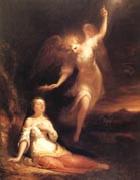 |
Huntington Daniel
|
|
American Hudson River School Painter.
b.1816 d.1906
was born in New York City, New York, the son of Benjamin Huntington, Jr. and Faith Trumbull Huntington; his paternal grandfather was Benjamin Huntington, delegate at the Second Continental Congress and First U.S. Representative from Connecticut. In 1835 he studied with SFB Morse, and produced "A Bar-Room Politician" and "A Toper Asleep." Subsequently he painted some landscapes on the Hudson river, and in 1839 went to Rome. On his return to America he painted portraits and began the illustration of The Pilgrim's Progress, but his eyesight failed, and in 1844 he went back to Rome. Returning to New York around 1846, he devoted his time chiefly to portrait-painting, although he has painted many genre, religious and historical subjects. He was president of the National Academy from 1862 to 1870, and again in 1877-1890.
|
|
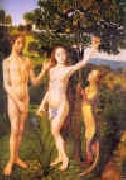 |
Hugo van der Goes
|
|
1440-1482
Flemish
Hugo van der Goes Galleries
Hugo became a member of the painters' guild of Ghent as a master in 1467. In 1468 he was involved in the decoration of the town of Bruges in celebration of the marriage between Charles the Bold and Margaret of York and he provided heraldic decorations for Charles's joyeuse entr??e to Ghent in 1469 and again in 1472. He was elected dean of the Ghent guild in 1473 or 1474.
In 1475, or some years later, Hugo entered Rooklooster, a monastery near Brussels belonging to the Windesheim Congregation, and professed there as a frater conversus. He continued to paint, and remained at Rooklooster until his death in 1482 or 1483. In 1480 he was called to the town of Leuven to evaluate the Justice Scenes left unfinished by the painter Dieric Bouts on his death in 1475. Shortly after this, Hugo, returning with other members of his monastery from a trip to Cologne, fell into a state of suicidal gloom, declaring himself to be damned. After returning to Rooklooster, Hugo recovered from his illness, and died there. His time at Rooklooster is recorded in the chronicle of his fellow monk, Gaspar Ofhuys. A report by a German physician, Hieronymus M??nzer, from 1495, according to which a painter from Ghent was driven to melancholy by the attempt to equal the Ghent Altarpiece, may refer to Hugo.
His most famous surviving work is the Portinari Triptych (Uffizi, Florence), an altarpiece commissioned for the church of San Egidio in the hospital of Santa Maria Nuova in Florence by Tommaso Portinari, the manager of the Bruges branch of the Medici Bank. The triptych arrived in Florence in 1483, apparently some years after its completion by van der Goes. The largest Netherlandish work that could be seen in Florence, it was greatly praised. Giorgio Vasari in his Vite of 1550 referred to it as by "Ugo d'Anversa" ("Hugo of Antwerp"). This the sole documentation for its authorship by Hugo; other works are attributed to him based on stylistic comparison with the altarpiece.
Hugo appears to have left a large number of drawings, and either from these or the paintings themselves followers made large numbers of copies of compositions that have not survived from his own hand. A drawing of Jacob and Rachel preserved at Christ Church, Oxford is thought to be a rare surviving autograph drawing.
|
|
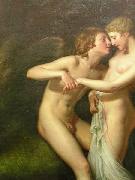 |
Hugh Douglas Hamilton
|
|
(c. 1740 - 10 February 1808) was an Irish portrait-painter.
Biography
Hamilton was born in Crow Street, in Dublin, Ireland, in 1740, the son of a peruke maker. Unfortunately there is very little concrete evidence for his earlylife, apart from his own drawings. He studied art under Robert West at the Dublin Society House - and won some early success with crayon and pastel portraits there. He was very adept at building relationships with patrons from the early days, taking up with the famous La Touche banking family of Dublin, who had close ties with the Bank of Ireland.
Very little is known of Hamilton's career between 1756 and 1764, when he moved to London. Hamilton found great success in London through his pastel oval portraits, portraying royalty, politicians and celebrities of the day through this medium. Hamilton was often overwhelmed with orders, including commissions from the British royal family - such as Queen Charlotte (1764) and others now in the British Royal Collection. He showed with the Society of Artists and the Free Society of Artists from the mid-1760s to the mid-1770s. From the mid-1770s on, Hamilton became very interested in a softer, more textural form of pastel "fresco", in which he blended crayons and chalk to further the pastel's ability to imitate flesh.
In 1779 he travelled to Italy, where he remained for the next twelve years, occasionally visiting Florence but mainly based in Rome, where he knew Antonio Canova. On the advice of artist John Flaxman Hamilton turned to oil painting, and achieved great success with small oval portraits of Irish and British visitors. His portraits of this period include those of Dean Kirwan (displayed at the Royal Dublin Society), George John, 2nd Earl Spencer, Countess Cowper (1787), and the exiled Charles Edward Stuart ( Lord Edward, 1785).
In 1791 Hamilton returned to Dublin, where he died. In 1796 he painted Lord Edward Fitzgerald, the Irish revolutionary.
|
|
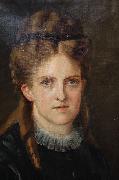 |
Horst Devens
|
|
painted Freiin Emma von Langenmantel-Rosenberg in 1873
|
|
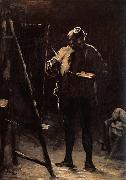 |
Honore Daumier
|
|
French Realist Illustrator, 1808-1879
was a French printmaker, caricaturist, painter, and sculptor, whose many works offer commentary on social and political life in France in the 19th century. A prolific draftsman who produced over 4000 lithographs, he was perhaps best known for his caricatures of political figures and satires on the behavior of his countrymen, although posthumously the value of his painting has also been recognized. Daumier was born in Marseille to Jean-Baptiste Louis Daumier and C??cile Catherine Philippe. His father Jean-Baptiste was a glazier whose literary aspirations led him to move to Paris in 1814, seeking to be published as a poet. In 1816 the young Daumier and his mother followed Jean-Baptiste to Paris. Daumier showed in his youth an irresistible inclination towards the artistic profession, which his father vainly tried to check by placing him first with a huissier, for whom he was employed as an errand boy, and later, with a bookseller. In 1822 he became prot??g?? to Alexandre Lenoir, a friend of Daumier's father who was an artist and archaeologist. The following year Daumier entered the Acad??mie Suisse. He also worked for a lithographer and publisher named Belliard, and made his first attempts at lithography. Having mastered the techniques of lithography, Daumier began his artistic career by producing plates for music publishers, and illustrations for advertisements.
|
|
 |
Honore Daumier
|
|
1808-1879
French
Honore Daumier Locations
In some 40 years of political and social commentary Honore Daumier created an enormously rich and varied record of Parisian middle-class life in the form of nearly 4,000 lithographs, about 1,000 wood engravings, and several hundred drawings and paintings. In them the comic spirit of Moli??re comes to life once again. After having been the scourge of Louis Philippe and the July Monarchy (1830-1848), Daumier continued as a satirist of Louis Napoleon and the Second Empire (1851-1870). Poor himself, the artist sympathized with the struggling bourgeois and proletarian citizens of Paris. As a man of the left, he battled for the establishment of a republic, which finally came in 1870. Liberals have always applauded Daumier; some conservatives, however, have been inclined to consider him woolly-minded.
Honore Daumier, born on Feb. 26, 1808, in Marseilles, was the son of a glazier. When Honore was 6, the family moved to Paris, where the elder Daumier hoped to win success as a poet. Honore grew up in a home in which humanistic concerns had some importance. A born draftsman and designer who was largely self-taught, he received some formal instruction from Alexandre Lenoir, one of Jacques Louis David students. An obscure artist named Ramelet taught Daumier the elements of the new, inexpensive, and popular technique of lithography. Daumier style is so much his own that it is not easy to disentangle influences from other artists. Rembrandt and Francisco Goya are usually mentioned, along with Peter Paul Rubens, the Venetian school, and photography.
|
|
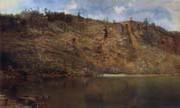 |
Homer Dodge Martin
|
|
American Barbizon School Tonalist Painter, 1836-1897, He was an American artist, particularly known for his landscapes. Martin was born at Albany, New York. A pupil for a short time of William Hart, his earlier work was closely aligned with the Hudson River School. He was elected as associate of the National Academy of Design, New York, in 1868, and a full academician in 1874. During a trip to Europe in 1876 he was captivated by the Barbizon school, and thereafter his painting style gradually became darker, moodier, and more loosely-brushed. From 1882 to 1886 he lived in France, spending much of the time in Normandy.
|
|
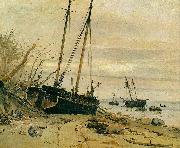 |
holger drachmann
|
|
född 9 oktober 1846 i Köpenhamn, död 14 januari 1908 i Hornbæk, var en dansk författare.
Drachmann försökte sig först på måleri, men gav upp och ägnade sig i stället åt författande. Han skrev noveller, dikter, romaner och skådespel.
Edvard Grieg satte musik till många av Drachmanns dikter, bland annat Reiseminder fra Fjeld og Fjord, opus 44. En av hans mest berömda dikter är Et andnat Skagen.
|
|
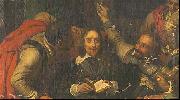 |
Hippolyte Delaroche
|
|
(17 July 1797 - 4 November 1856), commonly known as Paul Delaroche, was a French painter born in Paris. Delaroche was born into a wealthy family and was trained by Antoine-Jean, Baron Gros, who then painted life-size histories and had many students.
The first Delaroche picture exhibited was the large Josabeth saving Joas (1822). This exhibition led to his acquaintance with Theodore Gericault and Eugene Delacroix, with whom he became friends. The three of them formed the core of a large group of Parisian historical painters. He visited Italy in 1838 and 1843, when his father-in-law, Horace Vernet, was director of the French Academy in Rome.
Delaroche's studio in Paris was in the Rue Mazarine. His subjects were painted with a firm, solid, smooth surface, which gave an appearance of the highest finish. This texture was the manner of the day and was also found in the works of Vernet, Ary Scheffer, Louis-Leopold Robert and Jean Auguste Dominique Ingres. Among his students were British landscape artist Henry Mark Anthony (1817-1886),
|
|
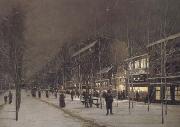 |
Hippolyte camille delpy
|
|
French, 1842-1910
was a painter. Delpy came from a moderately wealthy family from Joigny, in the Burgundy region of France. He was a student of Charles Francois Daubigny.
|
|
 |
Herri met de Bles
|
|
(also known as Herri de Dinant, Herry de Patinir, and Civetta) (c. 1510 - c. 1555 - 1560) was a Flemish Northern Renaissance and Mannerist landscape painter. He is also defined as a eeMosan landscape painter active during the second third of the 16thcentury (i.e., second generation of landscape painters).ee
Very little is positively known about the artist. He is believed to be a certain Herry de Patenir who joined Antwerp's Guild of St. Luke in 1535 as a painter and is also believed to be a court painter for the d'Este Dukes of Ferrara, where he ended his career known as "Il Civetta". He contributed, along with his possible-uncle Joachim Patinir, to a distinct style of Northern Renaissance landscape painting that combined small history or religious scenes into compositions defined by perspective and atmospheric effects. Also, along with a group of Antwerp-based followers of Hieronymus Bosch that included Jan Mandyn, Pieter Huys, and Jan Wellens de Cock, Met de Bles continued the tradition of fantastic imagery into northern Mannerism.
|
|
|
|
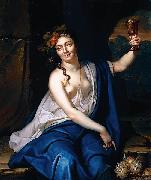 |
Herman van der Mijn
|
|
(1684, Amsterdam - 1741, London), was an 18th century painter from the Northern Netherlands.
According to Houbraken he introduced Jan van Nickelen to Jan Frans van Douven.
According to the RKD he learned to paint flowers from Ernst Stuven, and became a master of the Antwerp Guild of St. Luke in 1712, and the following year court painter to Johann Wilhelm, Elector Palatine. He took the family of Jan van Nickelen in tow to Dusseldorp, where they painted at court, and Van der Mijn taught Van Nickelen's daughter Jacoba Maria van Nickelen to paint flowers. She met the painters Rachel Ruysch and Willem Troost (whom Jacoba married) there. Van der Mijn returned to the Netherlands in 1717, but left on a trip via Brussels and Paris to London, where he stayed until 1737, when he took a trip to Leeuwarden
|
|
 |
Herbert James Draper
|
|
(1863 - 22 September 1920) was an English Classicist painter whose career began in the Victorian era and extended through the first two decades of the 20th century.
Born in London, the son of a jeweller named Henry Draper and his wife Emma,he was educated at Bruce Castle school in Tottenham and then went on to study art at the Royal Academy. He undertook several educational trips to Rome and Paris between 1888 and 1892, having won the Royal Academy Gold Medal and Travelling Studentship in 1889. In the 1890s he worked also as an illustrator, settling in London. In 1891 he married his wife Ida , with whom he had a daughter, Yvonne.He died of arteriosclerosis at his home at 15, Abbey Road, N.W.8 on 22 September 1920
|
|
|
|
 |
Henry de Groux
|
|
Belgian
1867-1930
Henry de Groux (1866 in Brussels - 1930 in Marseilles) was a Belgian Symbolist painter, sculptor and lithographer. His 1889 painting Christ aux Outrages, widely described as his masterwork, depicted Jesus being attacked by a mob. Later in life, he produced many works depicting the horrors of the First World War.
Ride of the Valkyries (ca. 1890)
Royal Museums of Fine Arts, Brussels, BelgiumDe Groux was a member of les XX, but was expelled when he refused to have his works displayed in the same gallery as Vincent van Gogh. He subsequently moved to Paris, where he befriended Emile Zola; during the social unrest resulting from the Dreyfus affair, de Groux acted as one of Zola's bodyguards.
As well, de Groux was a fervent diarist; beginning in 1892, he produced 18 volumes detailing the life of a European artist in the late 19th and early 20th centuries. In 2002, his descendants donated these volumes to the Institut national d'histoire de l'art; selected excerpts were published in 2007 Henry de Groux 1866-1930 - journal - Henry De Groux, Rodolphe Rapetti, Pierre Wat - Editions Kime.
|
|
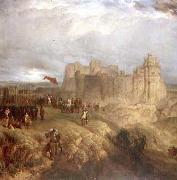 |
Henry Dawson
|
|
a landscape painter, was born in Hull in 1811, but came with his parents to Nottingham when an infant, so that he always regarded the latter as his native town. His parents were poor, and he began life in a Nottingham lace factory. But even while engaged in lace-making he continued to find time for art, and used to paint small pictures, which he sold at first for about half-a-crown each. In 1835 he gave up the lace trade and set up as an artist, his earliest patron being a hairdresser in Nottingham, who possessed a taste for art. In 1844 he removed to Liverpool, where after a time he got into greater repute, and received higher prices for his works. In 1849 he came with his family to London, and settled at Croydon, where some of his best pictures were painted. Among these may be reckoned 'The Wooden Walls of Old England,' exhibited at the British Institution in 1853, 'The Rainbow,' 'The Rainbow at Sea,' 'London Bridge,' and ' London at Sunrise.'
With the exception of six lessons from Pyne received in 1838, Henry Dawson was entirely a self-taught artist, and his art shows much originality and careful realism. He studied nature for himself, but he seems in later life to have been moved by Turner's influence to try more brilliant effects than he had before dared. Many of his works indeed are very Turneresque in treatment, though he can scarcely be called an imitator of Turner, for he had a distinct style of his own.
Henry Dawson, though painting much, and selling his pictures for high prices in his later life, remained, strange to say, very little known except to artists and connoisseurs until the large and very interesting collection of his works that was made for the Nottingham Exhibition in 1878 brought him wider fame. This exhibition showed him to be a genuine English landscape painter, of no great imaginative or intellectual power, but who delighted in nature, and represented her faithfully to the best of his ability. He died in December 1878, at Chiswick, where he had for some time resided.
|
|
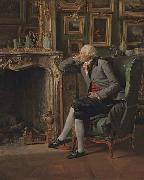 |
Henri-Pierre Danloux
|
|
(February 24, 1753 - January 3, 1809) was a French painter and draftsman.
He was born in Paris. Brought up by his architect uncle, Danloux was a pupil of Lepicie and later of Vien, whom he followed to Rome in 1775. In 1783, he returned to Lyon and Paris, where he was patroned by the Baronne Megret de Serilly d'Etigny, who secured for him a number of important portrait commissions. He emigrated to London in 1792 during the French Revolution and returned to Paris in 1801. Danloux was influenced by fashionable English portrait painters such as Thomas Lawrence (1769-1830), John Hoppner (1758-1810), and George Romney (1734-1802). In 1793, he exhibited at the Royal Academy in London which resulted in commissions from a number of British patrons. Danloux returned to Paris in 1801, and died there in 1809.
|
|
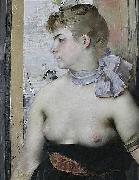 |
Henri-Lucien Doucet
|
|
(1856-1895) was a French figure and portrait painter, born in Paris, where he studied under Lefebvre and Boulanger, and in 1880 won the Prix de Rome. His pictures are usually piquant, sparkling representations of modern life, eminently Parisian in style, but the audacious realism of his earlier work is not maintained in his later, which is somewhat characterless. His portraits in pastel are also notable.
His most widely known picture is Apres le bal (After the Ball, 1889). Other excellent examples are the portraits of Celestine Galli-Marie as Carmen (1884, Marseille Museum), La princesse Mathilde Laetitia Wilhelmine Bonaparte and My Parents (1890, Lyons Museum), A Spanish Woman (Pontoise Museum), and Nude Figure (1890). He was awarded a first-class medal for pastel in 1889 and the Legion of Honour in 1891.
His painting A Skating Party, of 1893, was exhibited at the Chicago World Fair or the World's Columbian Exposition, which was held from May to October 1893 in Chicago in honour of the 400th anniversary of Columbus' discovery of the New World. Goupil made a limited edition first impression photogravure of the painting.
|
|
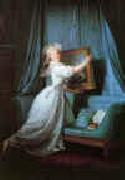 |
Henri Pierre Danloux
|
|
1753-1809 French
French painter and draughtsman. He was orphaned at an early age and was brought up by an uncle who was an architect and contractor. Around 1770 his uncle apprenticed him to Nicolas-Bernard Lpici. He exhibited for the first time in 1771 at the Exposition de la Jeunesse in Paris, where he showed a Drunkard at a Table (untraced). About 1773 he was admitted into the studio of Joseph-Marie Vien, whom he followed to Rome in 1775 on the latter appointment as Director of the Academie de France. Danloux sketchbooks show that he also travelled to Naples, Palermo, Florence and Venice. He was not interested in the monuments of antiquity but concentrated instead on drawing landscapes and, in particular, portraits, among them that of Jacques-Louis David.
|
|
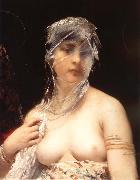 |
Henri Lucien Doucet
|
|
France
1856-1895
was a French figure and portrait painter, born in Paris, where he studied under Lefebvre and Boulanger, and in 1880 won the Prix de Rome. His pictures are usually piquant, sparkling representations of modern life, eminently Parisian in style, but the audacious realism of his earlier work is not maintained in his later, which is somewhat characterless. His portraits in pastel are also notable. His most widely known picture is Apres le bal (After the ball, 1889). Other excellent examples are the portraits of Madame Galli-Marie as Carmen (1884, Marseille Museum); the Princesse Mathilde and My Parents (1890, Lyons Museum); A Spanish Woman (Pontoise Museum); and a Nude Figure (1890). He was awarded a first-class medal for pastel in 1889 and the decoration of the Legion of Honor in 1891.
|
|
|
|
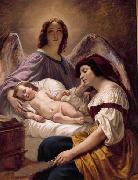 |
Henri Decaisne
|
|
a Belgian historical and portrait painter, was born at Brussels in 1799. As early as 1814 he began to study painting under François, and in 1818 upon the advice of David he went to Paris and entered the studio of Girodet, whence he removed to that of Gros. Several pictures by him are at Versailles; among them are the 'Entry of Charles VII into Rouen' (1838), and the 'Institution of the Order of St. John of Jerusalem' (1842). In 1839 he completed his colossal work, ' Les Belges Illustres.' He died in Paris in 1852. Among his best works are:
|
|
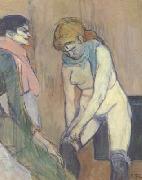 |
Henri de toulouse-lautrec
|
|
1864-1901
French painter and printmaker. He is best known for his portrayals of late 19th-century Parisian life, particularly working-class, cabaret, circus, nightclub and brothel scenes. He was admired then as he is today for his unsentimental evocations of personalities and social mores. While he belonged to no theoretical school, he is sometimes classified as Post-Impressionist. His greatest contemporary impact was his series of 30 posters (1891-1901),
|
|
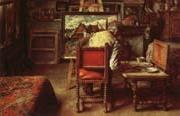 |
Henri De Braekeleer
|
|
Belgian Painter, 1840-1888
Belgian painter, was born at Antwerp. He was trained by his father, a genre painter, and his uncle, Baron Henri Leys, and devoted himself to scenes of everyday Antwerp life. The first pictures he exhibited, The Laundry (Van Cutsem collection, Brussels), and The Coppersmith's Workshop (Vleeshouwer collection, Antwerp), were shown. at the Antwerp exhibition in 1861. He received the gold medal at Brussels in 1872 for The Geographer and The Lesson (both in the Brussels gallery); the gold medal at Vienna in 1873 for The Painter's Studio and Grandmother's Birthday ; and the medal of honor at the Exposition Universelle at Amsterdam for The Pilot House. Among his more notable works are A Shoemaker (1862), A Tailor's Workroom (1863), A Gardener (1864, Antwerp gallery), Interior of a Church (1866), Interior, Flanders (1867), Woman Spinning (1869), Man Reading (1871), Theruedu Serment, Antwerp (1875), A Copperplate Printer, The Sailor's Return, The Man at the Window (Couteaux collection, Brussels), The Horn-blower (Couteaux collection), Man Retouching a Picture (Couteaux collection), The Potters (Marlier collection, Brussels), Staircase in the Hydraulic House at Antwerp (Marlier collection), and The Brewer's House at Antwerp (Marlier collection). The last, better known as A Man Sitting, is generally regarded as his masterpiece. As a lithographer and etcher, his work resembles that of Henri Leys.
|
|
|
|
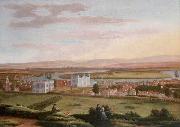 |
Hendrick Danckerts
|
|
(c.1625 - 1680) was a Dutch Golden Age landscape painter and engraver.
Danckerts was born in The Hague, where he learned his trade and remained until 1653.He visited England for the first time in 1650.In 1653 he went to Italy, where he stayed for five years. He then moved to England where he entered the service of Charles II and the Duke of York. He painted Italianate landscapes, especially views of harbors and royal residences. He also produced portraits and devotional pictures and made engravings after the Italian old masters in the Royal Collection. He left England in 1679due to the public hostility towards Roman Catholics after the Popish Plot controversy. He died soon after in Amsterdam.
|
|
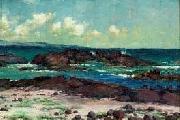 |
Helen Thomas Dranga
|
|
Helen Thomas Dranga (1866-1940), who is also known as Carrie Helen Dranga, was a painter who was born Carrie Helen Tufts in Oxford, England. She lived in Oakland, California from 1894 until 1900, when she moved to Hilo, Hawaii. Her paintings regularly appeared on the cover of Paradise of the Pacific magazine in the 1920s and 1930s. She lived in Hilo until shortly before her death in 1940.
The Honolulu Academy of Arts and the Lyman House Memorial Museum (Hilo, Hawaii) are among the public collections holding works by Helen Thomas Dranga
|
|
|
|
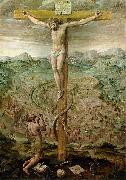 |
Hans Vredeman de Vries
|
|
(1527 - c. 1607) was a Dutch Renaissance architect, painter, and engineer. Vredeman de Vries is known for his publication in 1583 on garden design and his books with many examples on ornaments (1565) and perspective (1604).
Born in Leeuwarden and raised in Friesland, in 1546 Vredeman de Vries went to Amsterdam and Kampen. In 1549 he moved to Mechelen where the Superior Court was seating. Sebastian, his brother, was the organist in the local church. Vredeman de Vries designed ornaments for merry parades of Charles V and Philip II. Studying Vitruvius and Sebastiano Serlio, (translated by his teacher Pieter Coecke van Aelst), he became an internationally known specialist in perspective. He continued his career in Antwerp, where he was appointed city architect and fortification engineer. After 1585 he fled the city because of the Spanish occupation by Alessandro Farnese. Then the Protestants had to leave the city within two years. Vredeman de Vries moved to Frankfurt and worked in Wolfenbettel, designing a fortification and a new lay-out of the city for Julius, Duke of Brunswick-Leneburg. After his death the project was cancelled and Hans worked in Hamburg, Danzig (1592), Prague (1596) and Amsterdam (1600). On his trips Vredeman was accompanied by his son Paul and Hendrick Aerts.
Vredeman de Vries tried to get an appointment at the University of Leiden in 1604. It is not known when and where Hans Vredeman de Vries died, however, it is recorded that his son Paul was living in Hamburg when he inherited.
|
|
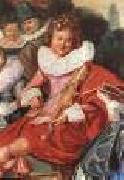 |
HALS, Dirck
|
|
Dutch painter (b. 1591, Haarlem, d. 1656, Haarlem).
Brother of Frans Hals. From 1618 to 1624 and again in 1640 he was an amateur of the Haarlem chamber of rhetoric known as De Wijngaertrancken, to which Frans also belonged. He was enrolled in the Guild of St Luke in Haarlem from 1627 to his death. As Blade has established on stylistic grounds, Dirck collaborated with the architectural painter Dirck van Delen from that year until 1634, with Hals painting the figures. On 4 April 1634 a lottery of paintings was announced, organized by Dirck Hals (who sent some of his own pictures) and Cornelis van Kittensteijn in the inn De Basterdpijp in Haarlem. The following year, on 20 June 1635, the notary van Leeuwen at Leiden authorized Dirck Hals to collect moneys for Pieter Jansz. van den Bosch of Leiden in connection with the proceeds of paintings sold at Haarlem. On 2 March 1643 Dirck Hals signed as a witness in the presence of the notary Willem van Vredenburch at Leiden.
|
|
|
|
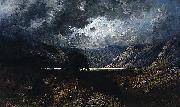 |
Gustave Dore
|
|
(French pronunciation: January 6, 1832 - January 23, 1883) was a French artist, engraver, illustrator and sculptor. Dore worked primarily with wood engraving and steel engraving.
Dore was born in Strasbourg and his first illustrated story was published at the age of fifteen. His skill had manifested itself even earlier, however. At age five he had been a prodigy troublemaker, playing pranks that were mature beyond his years. Seven years later, he began carving in cement. Subsequently, as a young man, he began work as a literary illustrator in Paris, winning commissions to depict scenes from books by Rabelais, Balzac, Milton and Dante.
In 1853, Dore was asked to illustrate the works of Lord Byron. This commission was followed by additional work for British publishers, including a new illustrated English Bible. A decade later, he illustrated a French edition of Cervantes's Don Quixote, and his depictions of the knight and his squire, Sancho Panza, have become so famous that they have influenced subsequent readers, artists, and stage and film directors' ideas of the physical "look" of the two characters. Dore also illustrated an oversized edition of Edgar Allan Poe's "The Raven", an endeavor that earned him 30,000 francs from publisher Harper & Brothers in 1883.
Dore's English Bible (1866) was a great success, and in 1867 Dore had a major exhibition of his work in London. This exhibition led to the foundation of the Dore Gallery in Covelant Bond Street. In 1869, Blanchard Jerrold, the son of Douglas William Jerrold, suggested that they work together to produce a comprehensive portrait of London. Jerrold had obtained the idea from The Microcosm of London produced by Rudolph Ackermann, William Pyne, and Thomas Rowlandson in 1808. Dore signed a five-year contract with the publishers Grant & Co that involved his staying in London for three months a year, and he received the vast sum of £10,000 a year for the project. Dore was mainly celebrated for his paintings in his day. His paintings remain world renowned, but his woodcuts and engravings, like those he did for Jerrold, are where he really excelled as an artist with an individual vision.
The completed book, London: A Pilgrimage, with 180 engravings, was published in 1872. It enjoyed commercial and socioeconomical success, but the work was disliked by many contemporary critics. Some of these critics were concerned with the fact that Dore appeared to focus on the poverty that existed in parts of London. Dore was accused by the Art Journal of "inventing rather than copying." The Westminster Review claimed that "Dore gives us sketches in which the commonest, the vulgarest external features are set down." The book was a financial success, however, and Dore received commissions from other British publishers.
|
|
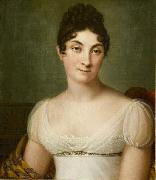 |
Guillaume Descamps
|
|
Guillaume-Desire-Joseph Descamps, a painter and engraver, was born at Lille in 1779. He was a pupil of Vincent, but, obtaining the "prix de Rome," he improved himself by travelling in Italy, and became court-painter of Murat in Naples. He died in Paris in 1858. The following paintings were executed by him:
The Women of Sparta (in the Lille Museum). 1808.
The Martyrdom of St. Andrew (in St. Andre, Lille).
Murat on board the Ceres distributing Rewards (engraved hy himself).
The Conversion of St. Augustine (in St. Eustache, Paris).
The Apotheosis of Cardinal Tommasi (in San Martino di Monti, Rome).
The Neapolitan Troops marching out against Capri.
|
|
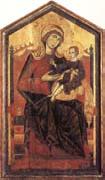 |
Guido da Siena
|
|
Italian Byzantine Style Painter, 13th Century
He may have made significant advances in the techniques of painting, much as Cimabue much later accomplished. However, there is some debate about this. Guido is primarily known for a painting which is now split into several pieces. The church of S. Domenico in Siena contains a large painting of the Virgin and Child Enthroned with six angels above. The Benedictine convent of the same city has a triangular pinnacle representing the Saviour in benediction, with two angels. This was once a portion of the same composition, which was originally a triptych. The principal section of this picture has a rhymed Latin inscription, giving the painter's name as Guido de Senis, with the date 1221. However, this may not be genuine, and the date may really read as 1281. There is nothing particular to distinguish this painting from other work of the same period except that the heads of the Virgin and Child are much superior ?C in natural character and graceful dignity ?C to anything painted before Cimabue. As a result, there is some dispute as to whether these heads are really the work of a man who painted in 1221, long before Cimabue. Crowe and Cavalcaselle have proposed that the heads were repainted in the 14th century, perhaps by Ugolino da Siena. If Crowe and Cavalcaselle are right, Cimabue maintains his claim to the advancement of the art. Beyond this, little is known of Guido da Siena. A picture in the Academy of Siena is attributed to him (a half-figure of the Virgin and Child, with two angels), which dates (probably) between 1250 and 1300.
|
|
|
|
|
|
|
|
 |
GIUSTO de Menabuoi
|
|
Italian painter, Florentine school (b. ca. 1320, Firenze, d. 1391,
Italian painter, Florentine school (b. ca. 1320, Firenze, d. 1391, was an Italian painter of the early Renaissance. He was born in Florence. In Lombardy he executed a fresco of the Last Judgement in the Abbey of Viboldone, Milan. He then moved to Padua where he completed frescos in the Church of the Eremitani, the Basilica of Saint Anthony of Padua and most notably, the Baptistery of the Duomo (1376).
|
|
|
|
|
|
|
|
|
|
|
| Wholesale China Oil Painting Wholesale Oil Painting China Xiamen Portrait Reproduction on canvas Chinese Oil Painting Wholesale USA Oil Painting |
|
|
|
|
|